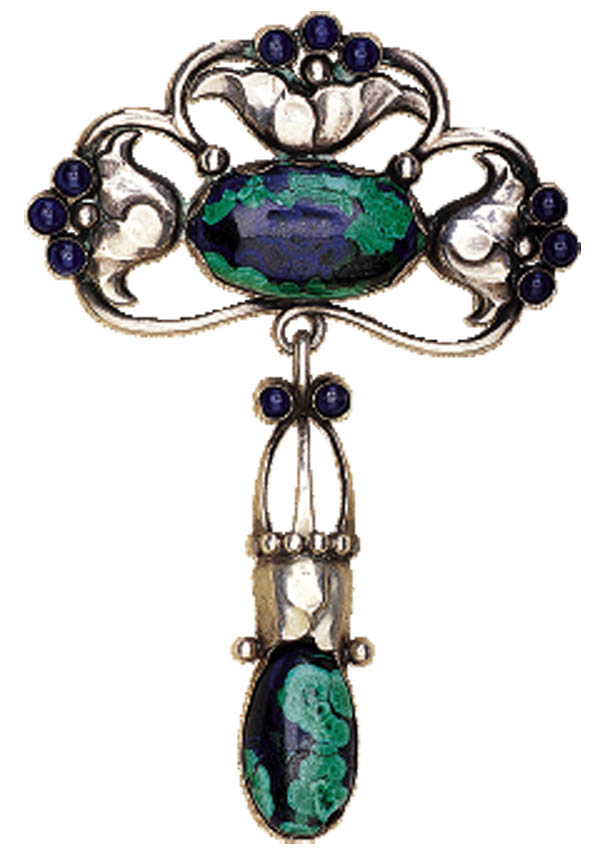Georg Jensen Silver (And More)
My love affair with Georg Jensen silver developed from a search for beautiful yet affordable jewelry. Years ago when I began to deal in antique jewelry, diamonds and gold were out of the question. Not only were they too costly, they didnt appeal to me aesthetically. Then I found my first piece of Georg Jensen silver. I knew immediately there was something magical about it, and to my further delight, I discovered I could afford to buy it.
The memory of finding that first piece of Georg Jensen silver is indelible. It was brooch no. 100B, sometimes referred to as the tulip pin. I wanted to know such things as: who designed the piece, how many examples were produced, what different stones were used, and how one design related to others within the Jensen canon. I began searching for answers in books, company catalogs, exhibition records, museum collections, and anywhere else I could find information. With each answered question, I gradually learned more not only about Jensen silver, but also about the fascinating man Georg Jensen - artist, sculptor, designer, silversmith, businessman, and family man.
Simultaneously, my involvement with other Jensen silver products grew as well. Though I initially bought and sold only Jensen jewelry, I soon found I could not stop there. I began to deal in Jensen flatware and serving pieces as well. Customers asked for other specific items, and I went out to find them. Before long, I was handling almost anything with the Jensen hallmark. What began as an attraction to Jensens wearable and affordable art jewelry grew to encompass virtually the totality of his work and the work of the designers employed by the firm he founded.
In Denmark and other European countries, a goldsmith is one who makes jewelry, a silversmith is one who raises silver to make hollowware, and a cutler is one who makes flatware. For the purpose of definition, hollowware refers to bowls, vases, desk implements, etc., anything that is not flatware. In the United States, jewelers make gold as well as silver jewelry. Georg Jensen is referred to as a silversmith in this text, although we know he made flatware, hollowware, and gold jewelry as well. Jensen referred to himself as a silversmith sculptor.
Characteristics of The Jensen Style
By 1904, Georg Jensens artistic vision seems to have crystallized into a unique style. While it continued to evolve in subtle ways throughout the rest of his life, his style exhibited a number of characteristics features, most of which consistently appear in his jewelry. An especially prominent feature is the use of vines, leaves, flowers, buds, and berries. Jensens interpretation of the vitality and motion of Art Nouveau is shown, not through the whiplash line favored by French artists, but through his own lyrical winding vines and leaves. Jensen imbues the graceful lines and silhouettes of fruit-like forms with his sculptural technique and silversmith's loving care for detail.
With respect to composition, Jensens jewelry is characterized by a superb integration of all design elements - lines, shapes, proportion, color and texture - translated into Jensens motifs and ornaments that result in a harmonious whole, a consummate whole. There is not a detail that could be added and there is nothing to be taken away to make each piece more perfect.
Jensens style is also characterized by the use of a large number of motifs, some that are interpretations of natural forms and others that appear to be decorative. The diversity of ways a motif is used in a medley of combinations is another Jensen characteristic. Another distinguishing feature of Jensens jewelry is a highly sculptural quality, attributable, of course, to Jensens training as a sculptor. He was able to transform the silver from a hard substance into a soft, pliable-looking material that begs to be touched.
The Materials In Jensen Jewelry
Jensen chose his stones, some opaque and some transparent, to represent a varied and exciting palette of colors. Most frequently he used onyx, carnelian, labradorite, amber, opal, coral, and moonstone. Although these stones were not precious and costly, their mounting - a silver bezel, beading, and sometimes leaves the couched the stone - was done with superb craftsmanship.
Hollowware
The Hollowware that Georg Jensen produced earned him international recognition during his lifetime. By prevailing artistic standards, a silversmiths elevation to the highest ranks within the profession could be determined by the quality of his hollowware, generally considered one of the zeniths of the silversmiths art.
Georg Jensens commitment to hollowware is evidenced by the large number of hollowware pieces he designed and produced during his career. Although his uniquely complementary skills as a sculptor, ceramist, and silversmith are discernible in all his work, they are perhaps expressed most fully and exuberantly in his hollowware. Literally, and figuratively, hollowware embodied his grandest artistic statements. And these were the statements that were primarily responsible for the accolades he received and the reputation he gained as one of the very best silversmiths of his era.
Flatware
Georg Jensen thought of dining as a sacred ritual through which family members could share nourishment and renew bonds. For him, the table was symbol of home and family, and he believed that beautiful flatware could enhance peoples lives by making dining a more pleasurable experience. Therefore, he designed flatware for everyday use that was functional and aesthetically pleasing.
Many of Jensens flatware designs were inspired by natural forms: flowers that resemble lilies trace handles, entwined fish form handles of fish-serving implements, a blossom with berries forms the ends of serving spoons, and leaves are engraved on a vegetable serving set.
During his career, Georg Jensen designed thirteen flatware patterns; eight have names and five have only numbers. The include: Klokke (Bell), Antik (Continental), Liljekonval (Lily of the Valley), Kugle (Beaded), Rope (Pearl), Akkeleje (no translation in English), Magnolie (Blossom), and Nordiske (Viking). Twelve other designers also created nineteen flatware patterns for the Jensen company between 1912 and 1981. The Acorn pattern, designed by Johan Rohde and introduced in 1916, is probably the best known and most popular of all Jensen flatware patterns. (This and several others of the original 33 sterling silver flatware patterns continue in production today.) The flatware patterns were given American names when the sales expanded to the United States. Sometimes, patterns were given other names that related to the country where the flatware was sold. For example, in England, the Nordic pattern was referred to as Hamlet.
- Janet Drucker
Editor's Note: for more information on books by Janet Drucker, visit Schiffer Books online at www.schifferbooks.com or Drucker Antiques at www.druckerantiques.com.















